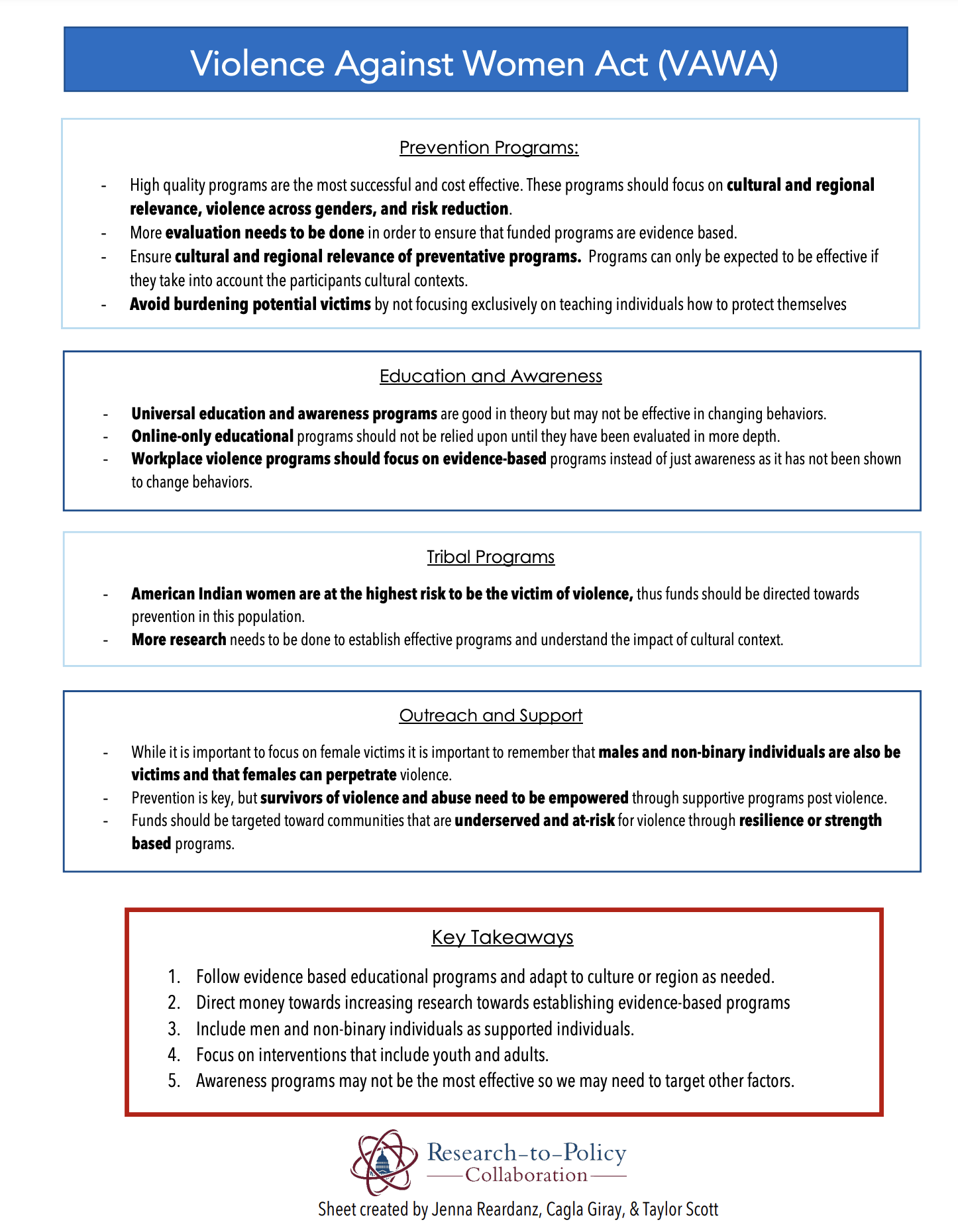
Prevention Programs
- High quality programs are the most successful and cost effective. These programs should focus on cultural and regional relevance, violence across genders, and risk reduction.
- More evaluation needs to be done in order to ensure that funded programs are evidence based.
- Ensure cultural and regional relevance of preventative programs. Programs can only be expected to be effective if they take into account the participants cultural contexts.
- Avoid burdening potential victims by not focusing exclusively on teaching individuals how to protect themselves
Education And Awareness
- Universal education and awareness programs are good in theory but may not be effective in changing behaviors.
- Online-only educational programs should not be relied upon until they have been evaluated in more depth.
- Workplace violence programs should focus on evidence-based programs instead of just awareness as it has not been shown to change behaviors.
Tribal Programs
- American Indian women are at the highest risk to be the victim of violence, thus funds should be directed towards prevention in this population.
- More research needs to be done to establish effective programs and understand the impact of cultural context.
Outreach And Support
- While it is important to focus on female victims it is important to remember that males and non-binary individuals are also be victims and that females can perpetrate violence.
- Prevention is key, but survivors of violence and abuse need to be empowered through supportive programs post violence.
- Funds should be targeted toward communities that are underserved and at-risk for violence through resilience or strength based programs.
Key Takeaways
- Follow evidence based educational programs and adapt to culture or region as needed.
- Direct money towards increasing research towards establishing evidence-based programs
- Include men and non-binary individuals as supported individuals.
- Focus on interventions that include youth and adults.
- Awareness programs may not be the most effective so we may need to target other factors.
The Research-to-Policy Collaboration (RPC) works to bring together research professionals and public officials to support evidence-based policy. Please visit their website to learn more.
Key Information
RPC Website
Research-to-Policy Collaboration
Publication DateJuly 1, 2019
Topic Area(s)Community-Specific, Violence and Victimization
Resource TypeWritten Briefs
Share This Page
Prevention Programs
- High quality programs are the most successful and cost effective. These programs should focus on cultural and regional relevance, violence across genders, and risk reduction.
- More evaluation needs to be done in order to ensure that funded programs are evidence based.
- Ensure cultural and regional relevance of preventative programs. Programs can only be expected to be effective if they take into account the participants cultural contexts.
- Avoid burdening potential victims by not focusing exclusively on teaching individuals how to protect themselves
Education And Awareness
- Universal education and awareness programs are good in theory but may not be effective in changing behaviors.
- Online-only educational programs should not be relied upon until they have been evaluated in more depth.
- Workplace violence programs should focus on evidence-based programs instead of just awareness as it has not been shown to change behaviors.
Tribal Programs
- American Indian women are at the highest risk to be the victim of violence, thus funds should be directed towards prevention in this population.
- More research needs to be done to establish effective programs and understand the impact of cultural context.
Outreach And Support
- While it is important to focus on female victims it is important to remember that males and non-binary individuals are also be victims and that females can perpetrate violence.
- Prevention is key, but survivors of violence and abuse need to be empowered through supportive programs post violence.
- Funds should be targeted toward communities that are underserved and at-risk for violence through resilience or strength based programs.
Key Takeaways
- Follow evidence based educational programs and adapt to culture or region as needed.
- Direct money towards increasing research towards establishing evidence-based programs
- Include men and non-binary individuals as supported individuals.
- Focus on interventions that include youth and adults.
- Awareness programs may not be the most effective so we may need to target other factors.
The Research-to-Policy Collaboration (RPC) works to bring together research professionals and public officials to support evidence-based policy. Please visit their website to learn more.

Key Information
RPC Website
Research-to-Policy Collaboration
Publication DateJuly 1, 2019
Topic Area(s)Community-Specific, Violence and Victimization
Resource TypeWritten Briefs
Share This Page
LET’S STAY IN TOUCH
Join the Evidence-to-Impact Mailing List
Keep up to date with the latest resources, events, and news from the EIC.




